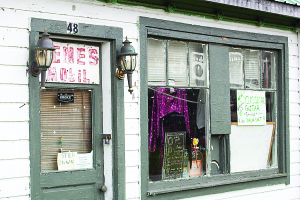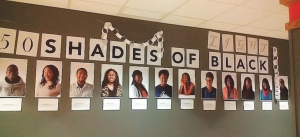Once a shoe repair shop, then a Mobil gas station and car garage, this enduring building located on Route 19 in downtown Houghton has a new role — it has been repurposed into a into a creative space for local musicians. The Van Name family, from Dalton, NY started the musical venue three years ago, which they are calling “The Music Lounge.”

The Van Names obtained the location, within walking distance, a few doors downs from 3 Bums, from Dawn Van Name’s father several years ago. Wanting to do something with the space, they decided to turn the old garage into a place for musicians to come play and audiences to come listen.
When the Van Names first acquired the garage, the inside was filled with typical garage items, such as a car lift and a giant air compressor. They spent the last three years clearing out and renovating the space to make it useable for concerts, jam sessions, and workshops. They have added a stage, lights, some cozy furniture, and a fridge to serve drinks. They have also incorporated some of the old knickknacks from the garage into decorations for the space, such as a vintage wooden rotary telephone and faded “posted” sign.
“The Music Lounge” has had several open mic nights since opening three years ago, said Johnny, Dawn’s son. Each event attracted about 10 to 15 attendees and some up to 20. They have had Houghton students and other musicians from across western New York come down to perform.
Benjamin and Jonathan Yuly, juniors, went to the venue twice their first year as students. Benjamin Yuly said he went the opening weekend to check it out and they were invited back to play. They went back a weekend later to “jam” with the the Van Name family at “The Music Lounge.” According to Yuly, the space has the typical feel that is common in most music lounges.
The family does music recordings in the lounge for local solo artists and bands. They want to keep a live feel and energy with the music they record. Johnny said, “Everything’s really over-produced nowadays, and I just want to get back to the live recordings. You know, still have it studio quality, but have the live feel.” The Van Names have already done recordings for local artists from the local area, including Cuba and Rochester. He said he is interested in getting more folk and acoustic artists in for live recordings.
Due to feedback from Houghton students expressing interest in jazz and other genres, Dawn would like to have various themed nights. Johnny suggested, “Different music like 80s, jazz and blues, and maybe a funk night would be cool.”
As another aspect of the business, Johnny makes handmade custom basses and guitars. He showed the bass he is working on right now for his friend — a Bigfoot design, with three toes, wood burned and hand-carved into the body. He hopes after finishing the “Bigfoot” bass guitar to move on to an acoustic guitar and even repair drum sets. Dawn wants the venue to be somewhere close for people to go for musical repairs.
Many people that have come to the lounge have stopped by on their way to the KOA campsite or Rushford Lake, Dawn said. She wishes to further network with people from out of state, New Yorkers from other parts coming to Rushford Lake, and the local population. She said, “We don’t want to be just one frame of thinking. We are trying to network out to everybody.”
One struggle, Dawn noted, has been scheduling. Many local musicians work and cannot get out on Friday nights, while others cannot do Saturday because they are busy running errands. Johnny also added that renovations have been another road block in the progress, but they are coming along.
Another problem the the lounge faced is that many students do not even know of the lounge’s existence. Yuly suggests there is a lot of potential in student interest and points out very little is known about the venue on campus. Sarah Slater, senior, said, “I have been here for three and a half years, plus a summer, I didn’t know about this.” Molly Freihoffer, senior, similarly did not know of “The Music Lounge.”
Dawn and Johnny said a specific genre they want to especially support are the local, original music artists. Dawn noted that it is exceedingly hard for them to get local venues and almost impossible to get paid for their time. Johnny said it is unfair to them to play solely for exposure and wants to help support them any way he and his family can.
Yuly believes there is a very active amateur and professional community of musicians in Allegany County because of local school teachers, churches, and the Greatbatch School of Music, as well as Alfred State and Alfred University. He believes all these groups could benefit from this type of venue.
In the future, Dawn and Johnny hope to start a summer community concert series with various musical artists outside, with snacks and drinks to create a fun environment. Johnny also wants to eventually create an online radio station to showcase local musicians from the Western New York area to further the support of original music.
Dawn said there are currently no planned events this semester, but added they are “open to helping students or anybody who has original music.” They want to be a supportive and creative place where students and community members can go to perform, practice, and record. They are open to any suggestions and possibilities for the future of “The Music Lounge.”
 Jordan stayed on Staten Island, the starting location, about a quarter mile away from the starting line. He said most participants stay in Manhattan and have to take the subway and ferry over, which takes hours. Instead he said he, “rolled out of bed, walked down the street to get a bagel and a cup of coffee and then walked over and ran the race.”
Jordan stayed on Staten Island, the starting location, about a quarter mile away from the starting line. He said most participants stay in Manhattan and have to take the subway and ferry over, which takes hours. Instead he said he, “rolled out of bed, walked down the street to get a bagel and a cup of coffee and then walked over and ran the race.”




 Before any of us current students came to Houghton, trays were removed from the dining hall to save the thousands of gallons of water it took to wash them. An admirable move for the environment, yes, but one that, it seems, has been called into question recently as we have more choices on bowl and plates sizes than anything else in the cafeteria.
Before any of us current students came to Houghton, trays were removed from the dining hall to save the thousands of gallons of water it took to wash them. An admirable move for the environment, yes, but one that, it seems, has been called into question recently as we have more choices on bowl and plates sizes than anything else in the cafeteria.
